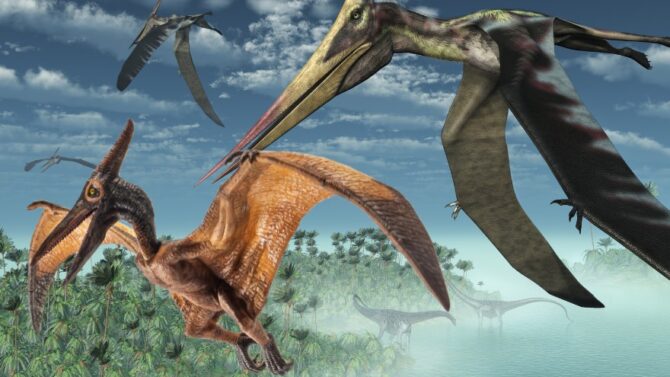Birds have many interesting features, like their colorful plumes and beautiful feathers.
However, their most outstanding feature is their sustained flight.
A notable example is the common swift, which can fly for ten consecutive months without stopping.1
While flying naturally is mostly attributed to birds, watching a paradise-flying snake glide through the air raises questions about whether other animal classes can fly. The kinematics of flying snakes suggests that reptiles can fly, but are there any flying reptiles today?
In this article, we explore whether reptiles can fly today and whether they could fly in the past.
What Animals Are Capable of Sustained Flight?
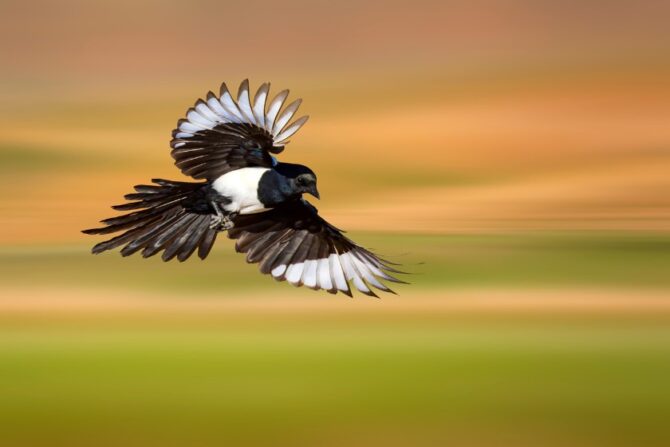
Many animals are capable of sustained flight, including insects like butterflies, dragonflies, bees, and flying bugs.
However, only three vertebrate taxonomic groups in history have evolved adaptations for powered flight: the pterosaurs (reptiles), birds (aves), and bats (mammals).
These groups have modified their forelimbs into wings, a biological organ that allows each species to fly.
While bats and birds exist today, pterosaurs lived millions of years before the end of the Mesozoic Era, sharing ancient airspace with avian dinosaurs.
Are There Any Flying Reptiles Today?

According to Britannica, flight in animals is a locomotive feature that can be classified into two types.2
The first is true or powered flight, exclusive to insects (most orders), most birds, and bats.
The second type is gliding, which is common among reptiles.
However, a more colloquial and narrow definition of flight is restricted to true flight.
In today’s world, no reptile is capable of true flight, as we will discuss later in the article.
Nonetheless, some reptiles possessed this ability millions of years ago, and today, some snakes and lizards can glide through the air.
Why Can’t Reptiles Fly Today?

Sustained flight is more than nature’s gift; it’s a feature with several biological modifications attached to it.
True flying vertebrates, such as birds and bats, are warm-blooded animals with winged forelimbs, light and fused bones, and short torsos.
They also have large thoracic muscles and hearts, improved vision, and other modifications that modern-day reptiles lack.
For instance, birds have a lightweight skeleton that helps them minimize flight energy and shape modifications that improve their flight, which reptiles lack.
Reptiles also lack the high metabolic rate of birds and bats, with birds boasting metabolic field rates ranging from five- (100 kilogram species) and 54-fold (1 gram species) higher than those of reptiles.
This shortcoming makes reptiles unable to produce the high energy necessary for soaring and gliding as birds do.
Moreover, reptiles lack a fully functional four-chambered heart, which is crucial for birds and bats to fly and survive.
Did Any Reptile Fly in The Past?
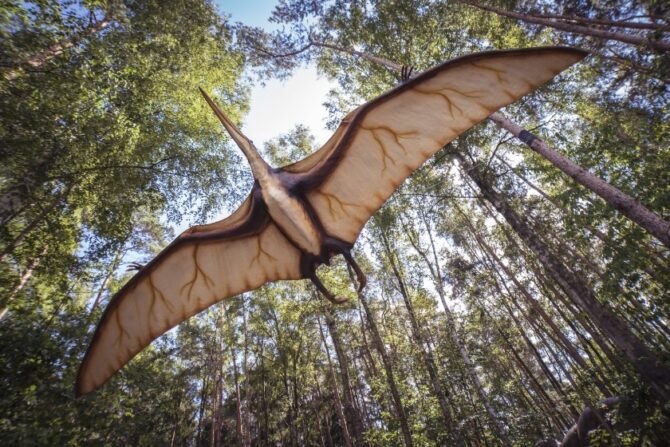
The Mesozoic Era, also known as the “age of dinosaurs,” might inspire images of flying dinosaurs, but in reality, no non-avian dinosaur could fly.
While modern-day reptiles lack the biological support to perform sustained flight, the Mesozoic Era witnessed some reptilian species flying millions of years ago.
This species, called pterosaurs, were capable of true flight and are considered ancestors of today’s birds.
Pterosaurs are the earliest vertebrates on record with sustained flight, thanks to their unique anatomy, which is different from other reptiles in their era and modern-day birds.
Their wings were made of a skin and muscle membrane, with complementary tissues extending from their ankles to an elongated fourth finger.
Pterosaurs lived from the earliest period of the Mesozoic era until the Cretaceous–Paleogene mass extinction event (228 to 66 million years ago) that wiped out dinosaurs and many reptilian clades.
Pterosaurs also had hollow bones lighter than those of modern-day birds.
Some scientists speculate they also had feathered bodies and used their wings like front paws during quadrupedal locomotion.
Although birds did not evolve from pterosaurs and were not classified as dinosaurs, they coexisted during the same geologic era.
In fact, these early birds are said to have evolved from theropod dinosaurs.
Why Are There No Flying Reptiles Today?
There are a few reasons behind the nonexistence of flying reptiles today; some are geological, while others are biological.
1. Mass Extinction Event

Pterosaurs, the only flying reptiles in history, went extinct during the Cretaceous–Paleogene mass extinction event that also wiped out non-avian reptilian dinosaurs.
Birds had evolved from avian dinosaurs before the catastrophe, surviving the extinction and diversifying continuously.
Unfortunately, pterosaurs lacked the necessary adaptive features to survive extinction, and evolution never gave reptiles the gift of self-sustained flight again.
2. Cold-Bloodedness
Cold-bloodedness is another reason there are no flying reptiles today.
This biological factor limits the agility of reptilians, as they rely on the external environment for thermoregulation.
While reptiles may be fast during warm temperatures, they are much slower when temperatures fall to lower degrees.
Performing a self-sustained activity like soaring and gliding through the air over long distances and periods demands much heat and energy.
As such, reptiles would find it challenging to fly in the cold air yet stay warm enough to continue flapping their wings.
The metabolism of reptiles is another factor limiting true flight; their metabolic rates are slower than birds and bats, constraining their speed and agility.
Which Reptiles Have an Alternative Ability to Self-Sustained Flight?
When thinking about reptiles that can fly today, flying snakes, such as the paradise flying snake, readily come to mind.
However, these snakes are only expert gliders with impressive adaptations that help them achieve this form of locomotion.
In this section, we’ll explore two types of reptiles that are known to be excellent gliders today.
1. Draco Lizards
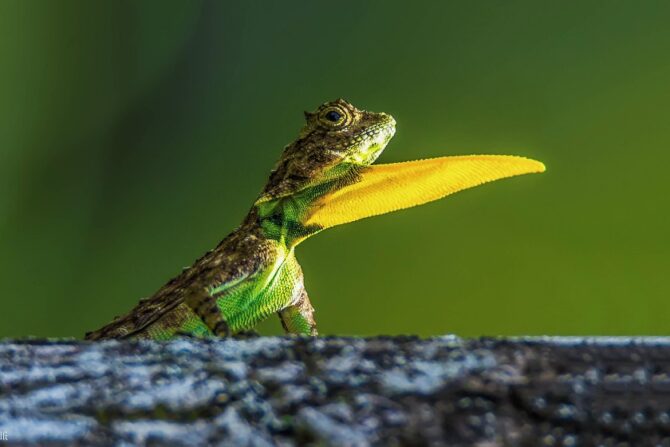
Draco lizards are in serious contention for being the next pterosaurs, with names like flying lizards, flying dragons, or gliding lizards that suggest their excellent gliding abilities.
Draco is a genus of reptiles that can glide through the air despite lacking powered or self-sustained flight.
Typically, they do this by stretching their membranous arms, called patagia, which function as wings.
Many animals, including extinct species like pterosaurs and some dromaeosaur species and extant species like bats and flying frogs, have patagia.
However, this membranous organ reveals an outfit of overgrown ribs with a solid structure.
Draco lizards use their gliding flight to travel from tree to tree and escape predators swiftly.
According to British zoologist Ross Piper in his book Extraordinary Animals: An Encyclopedia of Curious and Unusual Animals, a 7.9-inch adult lizard could travel two hundred feet, losing only thirty-three feet in height.
The aerial behavior of Draco lizards is characterized by them positioning their body horizontally in the air before spreading their patagia.3
This allows their hind legs to expand and helps them land horizontally with their forelimbs before their hind limbs.
2. Flying Snakes
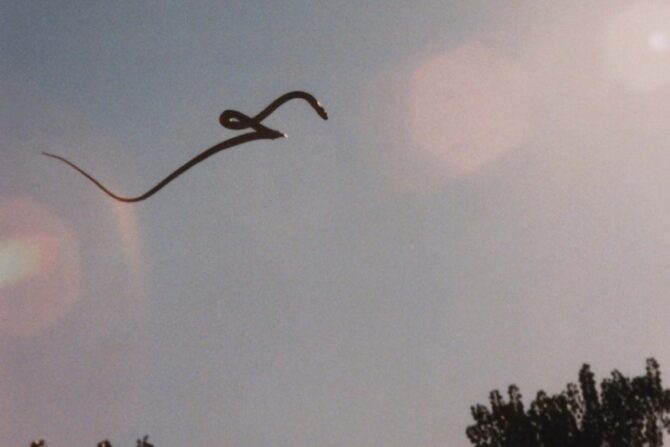
Southeast Asia’s fauna diversity houses the closest genus of animals to what we may term “flying reptiles.”
While a snake’s venom is perhaps its most intriguing feature, the remarkable gliding ability of flying snakes thrills many.
It’s important to always be on the watch for snakes that can glide through the air for impressive distances without wings or any specific organ for self-sustained flight.
These mildly venomous snakes climb vertically to treetops until a small percentage of their body, perhaps their tail, dangles from the tree.
Making a J-shape bend, the snake adjusts itself, determining the inclination to control its glide path and landing spot.
While Draco lizards expand their patagia, flying snakes propel themselves by hoisting their bodies from the tree, sucking in their abdomen, and flaring out their ribs.
Flying snakes make the continuous serpentine movement of sideways undulation parallel to the ground, helping them stabilize their direction in midair to land safely.4
While birds and bats expend high energy levels during flight, flying snakes spend less energy by gliding through the air.
What Can Reptiles Do Besides Slither and Crawl?
Despite being unable to fly, reptiles are not so limited in their locomotion.
As you now know, some reptiles can glide through the air.
Many people assume non-gliding reptiles can only slither or crawl slowly, but this couldn’t be any further from the truth.
In reality, reptiles have other locomotive skills than these, some of which are listed below.
1. Climbing
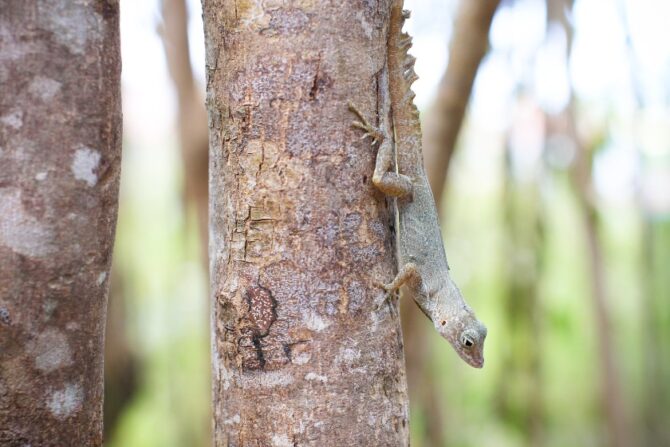
Tortoises might be slow crawlers, but most reptiles, including snakes and lizards, can climb up to incredible heights at impressive speeds.
Some of these species are arboreal and rely on their locomotive ability to climb.
However, these reptiles are not limited to climbing trees, as snakes and lizards can climb up walls and stairs.
It is understandable to expect lizards to climb as they have limbs, but limbless snakes possess marvelous climbing skills thanks to adaptive modifications over several years.
Snakes use their scales and specific muscles to grip surfaces.
Sadly, tortoises and their aquatic reptilian counterparts, turtles, are generally slow crawlers that cannot climb steep surfaces.
While they can climb minor degrees of inclination, they will tumble over if they attempt to go up steep surfaces.
2. Swimming
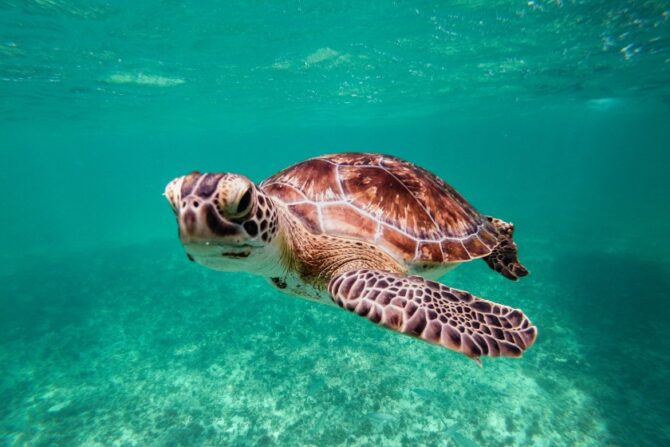
Reptiles like turtles and crocodiles can spend considerable time in the water, with the former being excellent swimmers with natural buoyancy.
While the air is not a suitable medium for locomotion, water is more friendly to reptilian life.
Although turtles fall short when it comes to climbing and crawling, they make up for this with their excellent swimming abilities.
It’s interesting to note that some snakes can also swim.
Swimming for reptiles is attributed to a species’s natural habitat.
Little wonder desert snakes and lizards are poor swimmers, unlike those inhabiting wet, riverine, and marshy areas.
Some snakes, like the ball python, swim out of necessity. While they can swim excellently when necessary, they do not prefer to travel this way.
3. Jumping
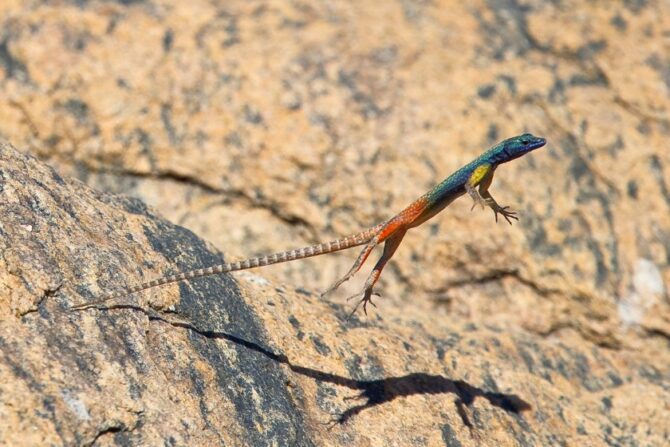
Many reptiles are excellent long and high jumpers, especially most lizard species with long, sturdy legs supporting their locomotion.
Sadly, turtles and tortoises are terrible jumpers due to their restrictive anatomy.
Most snake species raise a considerable percentage of their bodies when attacking prey, but they can’t push their body fully off the ground.
As such, they cannot be called jumpers since they do not leap.
However, flying snakes are an exception, leaping from tall trees and maintaining a significant distance before touching the ground.
Frequently Asked Questions
What Is an Example of a Flying Reptile?
Pterosaurs, one of the most iconic prehistoric creatures, were flying reptiles that filled the skies during most of the Mesozoic Era, from the Late Triassic through the Cretaceous period’s end (possibly between 228 and 66 million years ago).
What Is the First Animal to Fly?
While birds are the world’s fastest-flying animals, with adaptive modifications supporting their locomotion, they are far from being the first creatures to fly.
According to research, pterosaurs are the first animals to perform self-sustained air-borne locomotion.
Why Are There No More Flying Reptiles?
The only confirmed group of flying reptiles, the pterosaurs, went into extinction at the end of the Mesozoic Era’s Cretaceous period, during the Cretaceous-Paleogene mass extinction event that wiped out all dinosaurs.
Can Cold-Blooded Animals Fly?
Like reptiles, cold-blooded vertebrates, including amphibians, lack powered flight.
However, some amphibians, including flying frogs, can glide through the air at an angle of no more than 45 degrees.
Are There Flying Invertebrates?
Self-sustained flight is not exclusive to winged, warm-blooded vertebrates like birds and bats.
Many invertebrates, like insects, can achieve true flight.
These include species like butterflies, dragonflies, bees, and several others.
Wrapping Up
Reptiles are undoubtedly intriguing creatures with fascinating features.
Millions of years ago, many flying reptiles filled the skies and witnessed the evolution of birds.
However, their extinction led to generations of reptilian species lacking the highly-rated ability of self-sustained flight.
So, to answer the question, “Are there any flying reptiles today?”—no, there aren’t any flying reptiles today.
However, we can take comfort in knowing that gliding lizards and flying snakes can glide excellently, which is as close to flying as anything.
References & Notes
- The Common Swift Is the New Record Holder for Longest Uninterrupted Flight. Audubon
- Flight | Bird Flight, Aerodynamics & Gliding. Britannica
- How lizards fly: A novel type of wing in animals. National Library of Medicine
- Undulation enables gliding in flying snakes. Nature Physics
